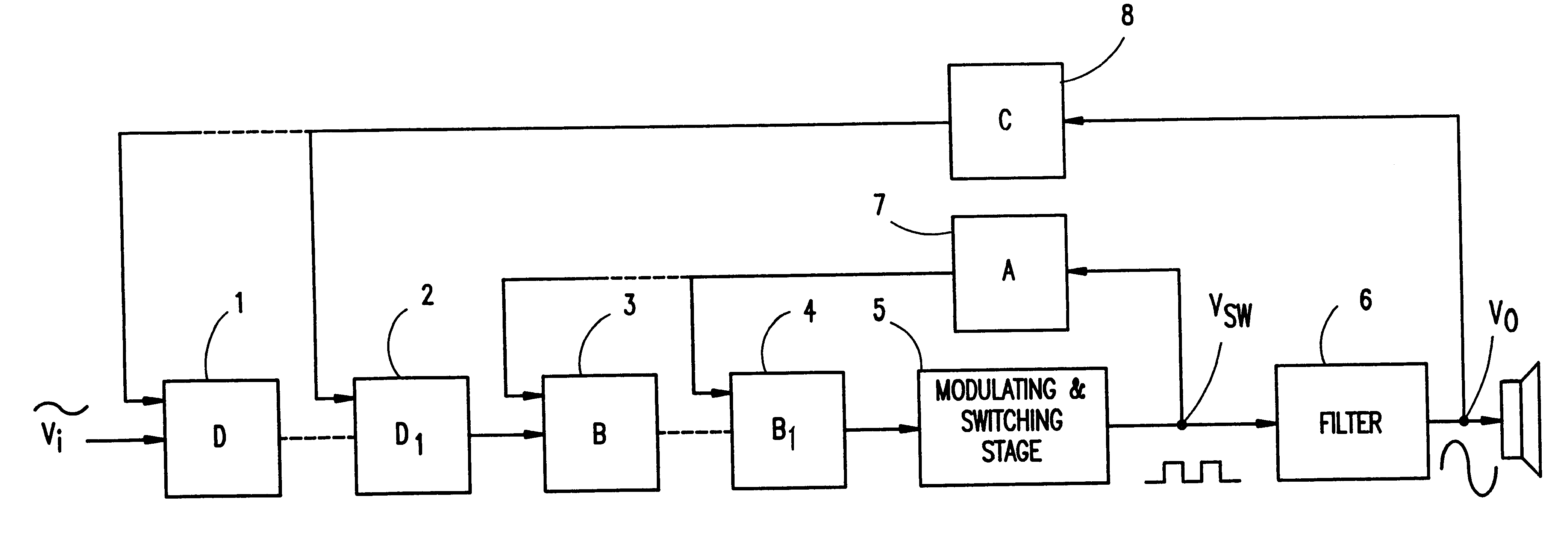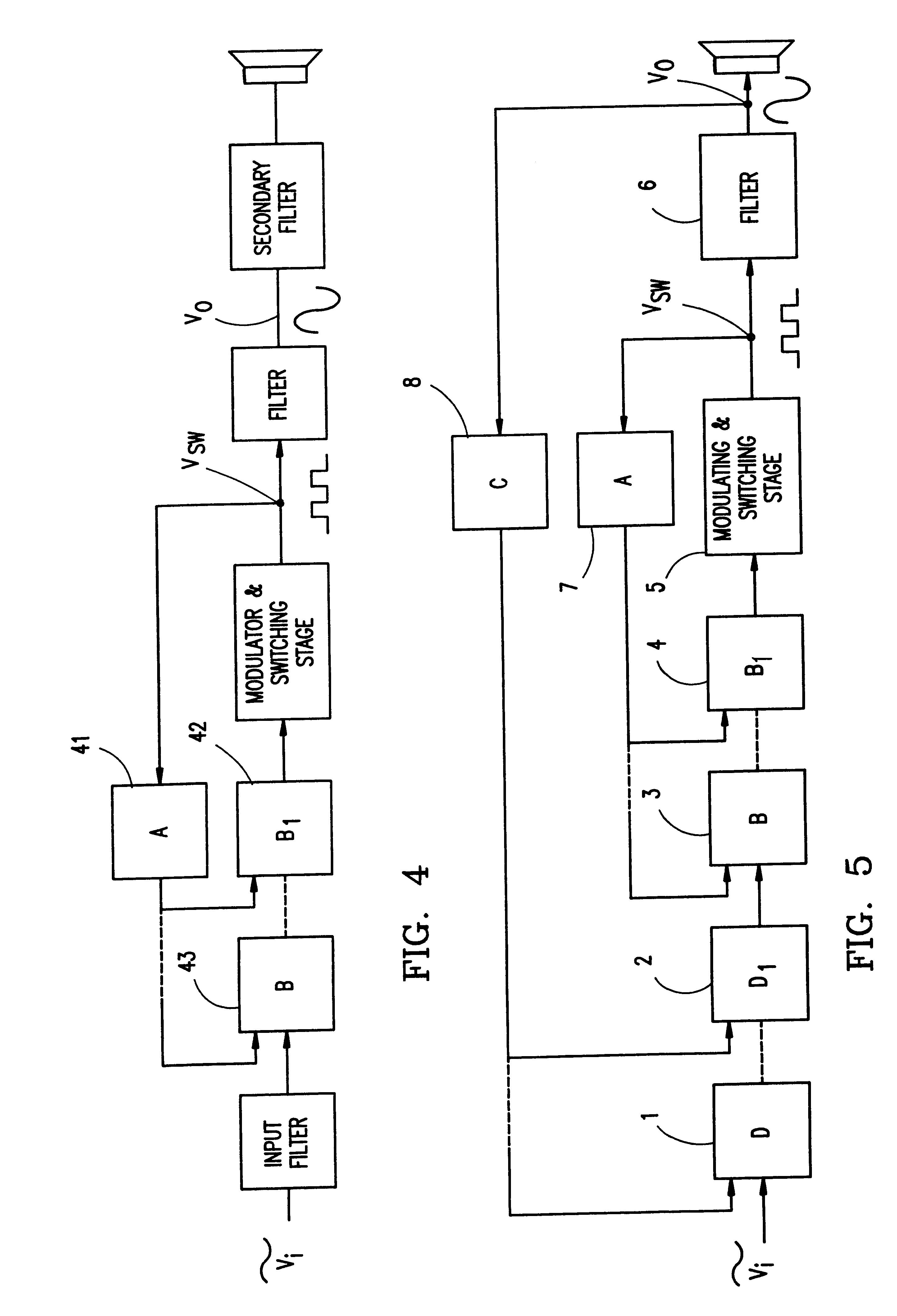Pulse modulation power amplifier with enhanced cascade control method
a power amplifier and enhanced cascade technology, applied in power amplifiers, amplifiers, electric devices, etc., can solve the problems of low efficiency and heat dissipation, prior art in the field has not provided solutions with an acceptable audio quality, and the use of digital power amplification has been limited
- Summary
- Abstract
- Description
- Claims
- Application Information
AI Technical Summary
Benefits of technology
Problems solved by technology
Method used
Image
Examples
fourth embodiment
The lowpass characteristic of the feedback path is beneficial in several aspects. It causes a closed loop zero-pole phase lead characteristic which can be very useful for realizing a cancellation of one of the poles of the demodulation filter. Furthermore, the pole causes an important filtering of the high frequency switching noise from the power stage output, which is essential when carrier based modulation methods are used (the invention). In this simple exanplary embodiment the initial forward block is a simple gain, with a gain that leads to a constant open loop and closed loop gain of K in the frequency band of interest: ##EQU2##
Whereas the i'th block has a pole-zero characteristic to compensate for the zero-pole characteristic of the preceding loop: ##EQU3##
By this realization the open loop gain of the single loop configuration can be written by the following 1. order expression: ##EQU4##
It is easy to show that for all loops: ##EQU5##
The closed-loop transfer function can be ap...
first embodiment
The second embodiment of the invention involves the extension of the first embodiment to a dual feedback Multivariable Enhanced Cascade Control (MECC)structure, were the two cascades are closely connected. A general block diagram is illustrated in FIG. 5. The system relies on the zero-pole lead characteristic caused by the single lowpass feedback path of the local enhanced cascade. Due to the use of two feedback sources, this embodiment is termed Dual feedback Multivariable Enhanced Cascade Control. The second cascade has the same special characteristics as the first cascade with only one single feedback path C and a set of forward path blocks D.sub.i. One preferred approach of dual feedback MECC design is based on the local enhanced cascade in FIG. 6a and illustrated in FIG. 6b. The main reconstruction filter F(s) is assumed to be 2. order. The feedback path has a constant gain characteristic: ##EQU7##
The initial block forward block D.sub.1, is a simple gain block with a gain in th...
third embodiment
THE INVENTION
A further preferred embodiment regarding modulator implementation for the MECC digital power amplifier is a Controlled self-Oscillating Pulse Modulator, new to the art. An example of an embodiment realizing this method is shown in FIG. 10. The preferred method is characterized by having a non-hysteresis comparator as a modulator and by modifying the first local loop to a have higher order characteristic, by an additional pole in both forward path block B.sub.1 and feedback path A. This secures controlled and stable self-oscillating conditions. The desired pulse modulation effect is then obtained by superposing the oscillating signal with the signal input (V.sub.i). FIG. 11 shows an example of the signal characteristics at the reference point for the modulator where the oscillating signal is superposed with the input signal. Furthermore, the pulse modulating effect is shown.
Advantages of the above described Controlled self-Oscillating Pulse Modulator over constant freque...
PUM
 Login to View More
Login to View More Abstract
Description
Claims
Application Information
 Login to View More
Login to View More - R&D
- Intellectual Property
- Life Sciences
- Materials
- Tech Scout
- Unparalleled Data Quality
- Higher Quality Content
- 60% Fewer Hallucinations
Browse by: Latest US Patents, China's latest patents, Technical Efficacy Thesaurus, Application Domain, Technology Topic, Popular Technical Reports.
© 2025 PatSnap. All rights reserved.Legal|Privacy policy|Modern Slavery Act Transparency Statement|Sitemap|About US| Contact US: help@patsnap.com



